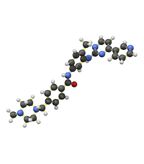Imatinib Discontinuation in Chronic Phase CML Doesn’t Always Lead to Relapse
Almost half of patients with chronic-phase chronic myeloid leukemia (CML) who discontinued imatinib treatment did not relapse, according to results of a prospective study. Those who did relapse showed continued sensitivity to imatinib when treatment started again.
Almost half of patients with chronic-phase chronic myeloid leukemia (CML) who discontinued imatinib treatment did not relapse, according to results of a prospective study. Those who did relapse showed continued sensitivity to imatinib when treatment started again.

Ball-and-stick model of imatinib
“Around 40% of patients who remain on imatinib for more than 5 years will have undetectable minimal residual disease (UMRD),” wrote investigators led by David M. Ross, MD, of Flinders Medical Center in Australia, online ahead of print on May 23 in the journal Blood. Almost all patients with detectable minimal residual disease who stop tyrosine kinase inhibitor (TKI) therapy show rapidly rising levels of BCR-ABL, this may not be the case for those with UMRD. The new study examined whether discontinuation of imatinib could still yield sustained treatment-free remission in 40 patients.
The analysis showed that 18 of 40 patients (45%) had no evidence of molecular relapse after a median follow-up of 42 months since imatinib discontinuation. The relapses that did occur tended to occur quickly: 15 of 22 happened with the first 6 months of discontinuation of therapy, with a median of 3 months. No patients died and none progressed to advanced phase disease. The treatment-free remission rate at 2 years was 47.1%. Seven of the relapses occurred later, between 6 and 27 months after imatinib discontinuation.
Of the 18 patients in treatment-free remission, 5 had detectable BCR-ABL in their blood on at least one occasion; all were detected below threshold levels for loss of major molecular response. “These findings highlight the importance of confirming molecular relapse on two consecutive tests,” the authors wrote.
All patients who relapsed restarted imatinib treatment, all eight who lost major molecular response regained it after a median interval of 2 months.
An analysis of the risk factors for relapse among these patients showed that the duration of interferon-alfa treatment prior to imatinib was associated with relapse risk, as was the amount of time to achieve UMRD after switching from interferon to imatinib. Shorter duration of interferon treatment was associated with higher relapse risk, and a slower achievement of UMRD also correlated with higher risk.
“The finding that around 40% of chronic phase CML patients with stable UMRD on imatinib can stop treatment and remain in [treatment-free remission] is clinically important, and reproducible,” the authors wrote. A previous French study showed a nearly identical rate of treatment-free remission in a similar cohort of patients, and patients do not appear to develop resistant disease or resistance to treatment upon discontinuation.
“On the basis of this study and other published studies we believe that a carefully monitored trial of imatinib withdrawal can be undertaken safely in selected CML patients,” the authors concluded.
Newsletter
Stay up to date on recent advances in the multidisciplinary approach to cancer.
Highlighting Insights From the Marginal Zone Lymphoma Workshop
Clinicians outline the significance of the MZL Workshop, where a gathering of international experts in the field discussed updates in the disease state.